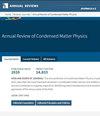从二维巴丁-库珀-施里弗到玻色-爱因斯坦凝聚的演变:交叉和拓扑量子相变
IF 30.7
1区 物理与天体物理
Q1 PHYSICS, CONDENSED MATTER
Annual Review of Condensed Matter Physics
Pub Date : 2024-03-11
DOI:10.1146/annurev-conmatphys-032922-115341
引用次数: 0
摘要
我们回顾了二维巴丁-库珀-施里弗(BCS)向玻色-爱因斯坦凝聚(BEC)演化的各个方面,这些方面现在已经与低密度系统相关,例如门控超导体 Li xZrNCl、魔角扭曲三层石墨烯、FeSe、FeSe1- xS x 和超冷费米超流体。我们强调化学势在决定单带和双带超流体和超导体的 BCS-BEC 演化过程中的交叉或拓扑量子相变方面所起的重要作用。我们强调,从 BCS 到 BEC 的交叉发生在非结点 s 波通道的配对中,而拓扑量子相变(其中阶参量对称性没有改变)发生在任何结点高角动量通道(如 d 波)的配对中。最后,我们讨论了有关二维 BCS 到 BEC 演化的几个开放性问题,包括阶参数的模量波动、临界温度的更严格上限,以及对双带超导体和超流体中晶格效应的探索。本文章由计算机程序翻译,如有差异,请以英文原文为准。
Evolution from Bardeen–Cooper–Schrieffer to Bose–Einstein Condensation in Two Dimensions: Crossovers and Topological Quantum Phase Transitions
We review aspects of the evolution from Bardeen–Cooper–Schrieffer (BCS) to Bose–Einstein condensation (BEC) in two dimensions, which have now become relevant in systems with low densities, such as gated superconductors Li x ZrNCl, magic-angle twisted trilayer graphene, FeSe, FeSe1− x S x , and ultracold Fermi superfluids. We emphasize the important role played by chemical potentials in determining crossovers or topological quantum phase transitions during the BCS–BEC evolution in one-band and two-band superfluids and superconductors. We highlight that crossovers from BCS to BEC occur for pairing in nonnodal s-wave channels, whereas topological quantum phase transitions, in which the order parameter symmetry does not change, arise for pairing in any nodal higher angular momentum channels, such as d-wave. We conclude by discussing a few open questions regarding the BCS-to-BEC evolution in 2D, including modulus fluctuations of the order parameter, tighter upper bounds on critical temperatures, and the exploration of lattice effects in two-band superconductors and superfluids.
求助全文
通过发布文献求助,成功后即可免费获取论文全文。
去求助
来源期刊

Annual Review of Condensed Matter Physics
PHYSICS, CONDENSED MATTER-
CiteScore
47.40
自引率
0.90%
发文量
27
期刊介绍:
Since its inception in 2010, the Annual Review of Condensed Matter Physics has been chronicling significant advancements in the field and its related subjects. By highlighting recent developments and offering critical evaluations, the journal actively contributes to the ongoing discourse in condensed matter physics. The latest volume of the journal has transitioned from gated access to open access, facilitated by Annual Reviews' Subscribe to Open initiative. Under this program, all articles are now published under a CC BY license, ensuring broader accessibility and dissemination of knowledge.
 求助内容:
求助内容: 应助结果提醒方式:
应助结果提醒方式:


